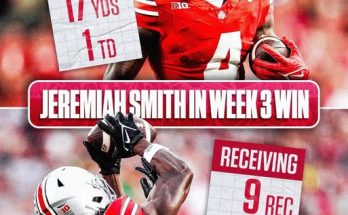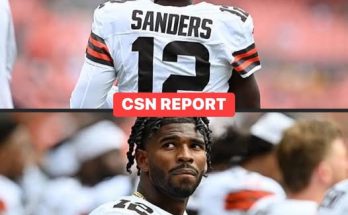LEGACY SHOWDOWN: Derrick Henry vs. Mark Ingram – Who Truly Defined the Alabama Dynasty?
When the word “Alabama” echoes through the halls of college football, it’s more than a name—it’s a legacy. A dynasty. A machine built on dominance, discipline, and championships. It evokes visions of crimson and white, relentless defense, clock-consuming power runs, and a coach whose sideline glare could stop a thunderstorm. But at the heart of Alabama’s meteoric rise and sustained excellence are the players—those rare athletes who carried the Tide and etched their names into college football immortality. Among the most iconic to ever wear the script “A” on their helmets are two Heisman-winning titans: Derrick Henry and Mark Ingram.
Both backs didn’t just play at Alabama—they defined Alabama. Ingram, the original groundbreaker, and Henry, the record-shattering juggernaut, were key figures in two separate waves of dominance under Nick Saban. Each left an indelible mark, not only on the stat sheets but in the culture, identity, and standard of what Alabama football would become. They were more than stars. They were pillars. But when discussing who truly defined the Alabama dynasty—who represents the very essence of the program’s ascension—the debate ignites. This is more than stats and trophies. It’s about influence, timing, leadership, and legacy.
Mark Ingram arrived in Tuscaloosa as part of Saban’s first full recruiting class in 2008. Coming off a 7–6 season, Alabama was rebuilding—not just a roster, but an identity. Ingram brought something Alabama hadn’t seen in a long time: swagger, grit, and the ability to change a game with one cut. By 2009, Ingram had become the face of a resurgent program, bulldozing his way through SEC defenses and carrying the Tide to their first national title since 1992. In doing so, he won the Heisman Trophy—the first in school history. That milestone alone cannot be overstated.
Ingram’s Heisman wasn’t just a personal achievement. It was a culture-shifting moment. Alabama, a program rich in tradition, had never before claimed the sport’s most prestigious individual award. With that bronze statue, Ingram announced to the world that Alabama was not just back—they were elite. His 1,658 rushing yards and 20 total touchdowns in 2009 came against some of the toughest defenses in the nation. More importantly, his performances in critical games—like his 246-yard outburst against South Carolina and his game-clinching drive in the SEC title game versus Florida—were the defining plays of a season that rewrote the school’s modern history.
Then came Derrick Henry, a different breed entirely. A giant among men even in high school, Henry’s record-setting prep career was the stuff of folklore. But even upon arrival at Alabama, questions persisted: Could his upright running style work in the SEC? Would he ever get enough carries to showcase his talents in Saban’s rotating backfield? The answers came loud and clear in 2015 when Henry took over the college football world with a season that defied logic and shattered records. That year, Henry rushed for 2,219 yards and 28 touchdowns on 395 carries—a workload that would have crushed lesser backs.
Henry wasn’t just great. He was unstoppable. Game after game, against elite competition, he wore down defenses like a steamroller, growing stronger as the game progressed. His 271-yard performance against Auburn, 204 yards in the SEC Championship against Florida, and relentless pounding of Michigan State and Clemson in the College Football Playoff became part of the myth. Like Ingram, Henry also took home the Heisman. But what made his run even more special was the sheer volume, the durability, and the magnitude of the performances when the stakes were highest.
So the question remains—who truly defined the Alabama dynasty?
If we begin with impact, Mark Ingram might have the edge. His 2009 campaign wasn’t just about stats or a trophy. It changed the perception of Alabama football in the modern era. Ingram helped lay the foundation for everything that followed. He proved that Alabama could produce top-tier offensive talent in addition to its historic defensive prowess. His leadership helped instill belief in a young team, and his performances often lifted Alabama out of tight spots. There is something to be said for being the first—the one who helped turn potential into reality.
But if we shift to dominance, Derrick Henry makes an overwhelming case. His 2015 season is one of the greatest ever by a college running back. He didn’t just break school records—he broke SEC records. He carried a heavier load than any Alabama back before him and delivered in virtually every big moment. Where Ingram was dynamic and balanced, Henry was a battering ram of inevitability, a human avalanche that buried defenses with every punishing step. His size-speed combination became the stuff of nightmares for opponents and legends for fans.
In terms of legacy, both players represent different things. Ingram symbolizes the beginning—the spark that ignited a dynasty. Henry represents the peak—the moment when Alabama’s machine was running at full capacity, chewing through opposition with precision and power. Ingram’s place in the Alabama pantheon is secure because of his timing and trailblazing. Henry’s is just as secure because of his sustained brilliance and record-breaking output.
Then there’s the matter of influence. Ingram’s success opened the door for future Alabama backs. It shifted perceptions nationally and on the recruiting trail. Before him, Alabama hadn’t produced a Heisman-winning skill player. After him, elite prospects started flocking to Tuscaloosa in droves, confident that they could shine even in a crowded backfield. Henry, on the other hand, redefined what an Alabama back could be. His combination of endurance and explosiveness set a new benchmark, and future backs—like Najee Harris and Brian Robinson—would try to follow in his enormous footsteps.
Off the field, both men continue to carry the Alabama flag with pride and distinction. Ingram’s charismatic presence and veteran leadership have made him a beloved figure in the NFL and beyond. He is vocal about his Alabama roots and remains connected to the program. Henry, meanwhile, is perhaps even more iconic in the pro game. His dominance with the Tennessee Titans has only added to his mystique, and his offseason training videos and philanthropic work have made him a global ambassador for what it means to be a Crimson Tide product.
From a fan perspective, the debate is deeply personal. Some fans idolize Ingram for lifting the program out of mediocrity and for showing what was possible. Others revere Henry for his unmatched production and for embodying the relentlessness that came to define the Saban era. Both are right. In truth, Alabama’s dynasty doesn’t exist without both players. Ingram started the fire. Henry turned it into an inferno.
Even Coach Nick Saban, when asked about his star running backs, has expressed admiration for both, noting their work ethic, humility, and team-first mentality. What sets both players apart is not just their talent, but their character. Neither craved the spotlight. Neither sought individual glory at the expense of team success. They embraced “The Process,” committed themselves fully, and left the program better than they found it.
So who truly defined the Alabama dynasty?
Maybe the question itself is flawed. Maybe the dynasty isn’t about one player, one moment, or one trophy. Maybe the dynasty is about a collection of greats who built upon each other’s legacies, brick by brick. Mark Ingram and Derrick Henry are not rivals—they are chapters in the same epic story. They represent the evolution of dominance, from the foundational to the formidable. Their paths were different, but their destinations were the same: greatness.
Still, if forced to choose, the answer depends on what you value more—being the pioneer or being the powerhouse. If you see the dynasty as a legacy built on transformation and cultural shift, then Ingram, the first Heisman winner and title-winner of the modern era, might be your answer. If you see it as a juggernaut defined by total dominance and historic production, then Henry stands tallest.
In the end, Alabama fans don’t have to choose. They were blessed to witness both. Two backs. Two Heismans. Two legends. And one dynasty that they helped define forever.



